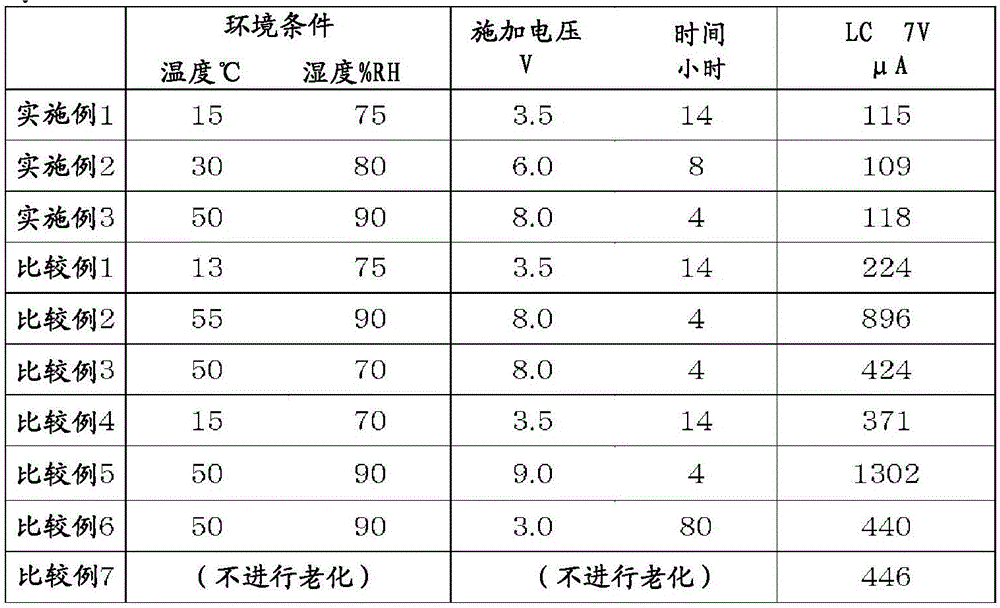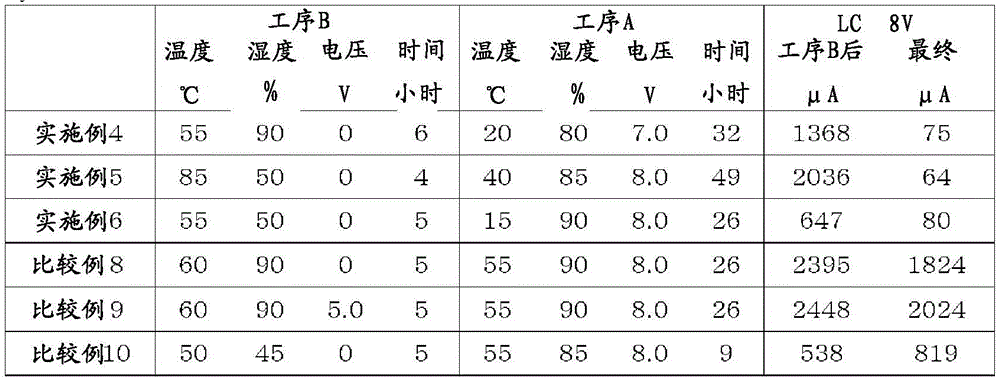Method for producing tungsten solid electrolytic capacitor element
A manufacturing method and capacitor technology, applied in the direction of electrolytic capacitor manufacturing, electrolytic capacitors, capacitor parts, etc., can solve the problems such as the leakage current of tungsten capacitors that cannot be solved, and achieve the effect of LC improvement
- Summary
- Abstract
- Description
- Claims
- Application Information
AI Technical Summary
Problems solved by technology
Method used
Image
Examples
Embodiment 1~3、 comparative example 1~7
[0066] [Production of sintered body]
[0067]0.40% by mass of tungsten primary powder with an average particle size of 0.8 μm (with a particle size range of 0.1 to 16 μm) mixed with tungsten primary powder obtained by hydrogen reduction of tungsten trioxide. ) of the crystalline silicon powder, placed under vacuum at 1420°C for 30 minutes. Return to room temperature and pulverize the block to obtain an average particle size of 75 μm (particle size range of 28 to 180 μm) and a bulk density of 3.0 g / cm 3 , The specific surface area is 1.3m 2 / g, a granulated powder having a silicon content of 0.40% by mass, an oxygen content of 0.52% by mass, and a nitrogen content of 0.04% by mass. A tantalum wire with a wire diameter of 0.29 mm was planted in the powder for molding, and sintered at 1500° C. for 30 minutes under vacuum to obtain a sintered body with a size of 1.0×1.5×4.5 mm mainly composed of tungsten ( Powder weight is 64mg, specific surface area is 0.71m 2 / g).
[0068] ...
Embodiment 4~6、 comparative example 8~10
[0086] In Example 1, a tungsten capacitor element was produced in the same manner as in Example 1 except that silicon was not added when producing the granulated powder, the chemical conversion voltage was 13V, and the post-chemical conversion voltage was 8V. The average capacitance of the 64 elements was 177 μF. The average LC value of the capacitor element at this stage was 519 μA at an applied voltage of 8 V.
[0087] Next, aging in step B was carried out under the conditions of temperature, humidity, and no applied voltage described in Table 2, and then aging in step A was carried out under the conditions of temperature, humidity, and applied voltage described in Table 2. Table 2 shows the measured values of LC of the capacitor elements after step A and after step B (final) (average value of 64 elements, applied voltage: 8V).
[0088] Table 2
[0089]
reference example 1
[0091] Sodium reduction is performed on potassium fluorotantalate to obtain a primary powder with an average particle size of 0.4 μm. The primary powder is granulated under vacuum at 1300° C. to obtain a block, and the block is crushed to obtain an average particle size It is the secondary powder of 110 μm (the particle size range is 26~180 μm), it is molded in the same manner as in Example 1, and is sintered at 1340° C. under vacuum for 30 minutes to obtain a sintered body with the same shape as in Example 1 (mass: 41 mg). Next, a dielectric layer, a semiconductor layer, a carbon layer, and a silver layer were sequentially formed in the same manner as in Example 1 to fabricate a tantalum solid electrolytic capacitor element. The average capacitance is 220μF, and the LC value at an applied voltage of 7V is 97μA, which is already below 0.1CV. In addition, the aging of step A was carried out under the conditions of Example 1 in Table 1 in this state, but the LC value was 103 μA...
PUM
 Login to View More
Login to View More Abstract
Description
Claims
Application Information
 Login to View More
Login to View More - R&D
- Intellectual Property
- Life Sciences
- Materials
- Tech Scout
- Unparalleled Data Quality
- Higher Quality Content
- 60% Fewer Hallucinations
Browse by: Latest US Patents, China's latest patents, Technical Efficacy Thesaurus, Application Domain, Technology Topic, Popular Technical Reports.
© 2025 PatSnap. All rights reserved.Legal|Privacy policy|Modern Slavery Act Transparency Statement|Sitemap|About US| Contact US: help@patsnap.com


